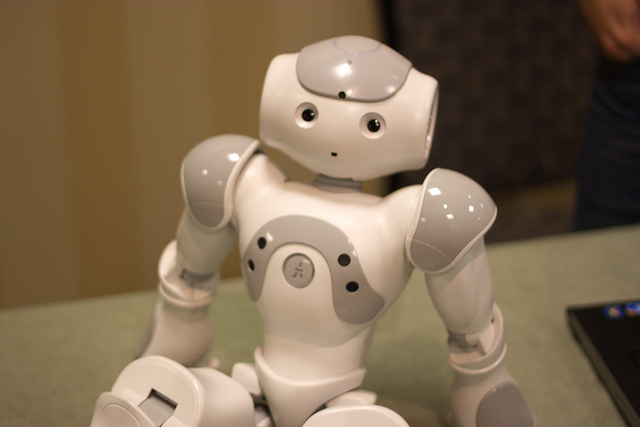Robotic Etiquette

Would touching a robot’s bum make you uncomfortable? A Stanford University study has suggested that we unconsciously respond to humanoid robots as if they are people rather than computers. Social conventions appear to play a role in our interaction with robots designed to look like humans1.
NAO, a small humanoid robot, was programmed to ask participants to touch 13 parts of its body2. Sensors connected to the participants recorded their emotional reaction time, as well as the electric conductivity of their skin. This measured emotional response: when we experience a strong emotional reaction, say from anxiety or desire, the skin becomes more conductive.
The researchers used an established “body accessibility” scale that ranks body parts based on people’s willingness to be touched there by others. The buttocks and genitals, for example, are “low accessibility” regions. Would touching a humanoid robot in a low accessibility area produce a similar emotional reaction to touching a human?
Although consciously aware that they were dealing with a robot, the participants unconsciously responded as if NAO was another person, seemingly because it looked and talked like a human. Participants showed signs of hesitation, increased alertness and improved attention when touching the intimate parts of the robot. One participant refused to touch these parts at all.
These reactions to body accessibility suggest that human social conventions may still apply to our interactions with humanoid robots. As the researchers explained, these primitive physiological responses occurred as we have not evolved to differentiate between humans and technology3. Previous studies have also shown similar results: for example, the same part of the brain is used to recognise both human and robot faces.
As robots are designed to take on social and emotional roles, such as caretakers, our unconscious reactions to physical contact become increasingly important. Touch could profoundly affect the design of future artificial systems – and the human-robot relationship itself.
References
- http://www.techtimes.com/articles/147580/20160406/touching-robots-in-sensitive-places-turn-on-humans-a-peek-of-things-to-come.htm
- http://www.techtimes.com/articles/147514/20160405/touching-robots-in-intimate-places-causes-arousal-discomfort.htm
- http://arstechnica.co.uk/gadgets/2016/04/how-would-you-feel-if-a-robot-asked-you-to-touch-its-buttocks/











“Hello very nice site!! Man .. Excellent .. Wonderful .. I will bookmark your site and
take the feeds additionally? I am glad to find numerous useful information here within the post, we’d like work out more techniques in this regard,
thanks for sharing. . . . . .”